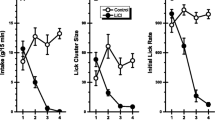Abstract
Wild animals eat fungi, yet mushroom poisonings in nature are unknown. The opossumDidelphis virginiana readily consumed the toxic mushroomAmanita muscaria, became ill, and then developed an aversion to the fungus. Both the illness and the aversion were due, in part at least, to the toxin muscimol. This appears to be the first demonstration of a mushroom chemical defense against fungivores and the first reported role in nature for an hallucinogen.
Similar content being viewed by others
References
Camazine, S.M., Resch, J.F., Eisner, T., andMeinwald, J. 1983. Mushroom chemical defense: Pungent sesquiterpenoid dialdehyde antifeedant to opossum.J. Chem. Ecol. 9:1439–1447.
Chilton, W.S. 1978. Chemistry and mode of action of mushroom toxins, pp. 110–115,in B.H. Rumack and E. Salzman (eds.). Mushroom Poisoning: Diagnosis and Treatment. CRC Press, West Palm Beach, Florida.
Domjan, M. 1977. Attenuation and enhancement of neophobia for edible substances, pp. 151–179,in L.M. Barker, M.R. Best, and M. Domjan, (eds). Learning Mechanisms in Food Selection. Baylor University Press, Texas.
Edmunds, M. 1974. Defence in Animals. Longman, Essex.
Eisner, T., andGrant, R.P. 1981. Toxicity, odor aversion, and “olfactory aposematism.”Science 213:476.
Fogel, R., andTrappe, J.M. 1978. Fungus consumption (mycophagy) by small animals.Northwest Sci. 52:1–31.
Garb, J.L., andStunkard, A.J. 1974. Taste aversion in man.Am. J. Psychiatry 131:1204–1207.
Garcia, J., andHankins, W.G. 1977. On the origin of food aversion paradigms, pp. 3–19,in L.M. Barker, M.R. Best, and M. Domjan, (eds.). Learning Mechanisms in Food Selection. Baylor University Press, Texas.
Garcia, J., andRusiniak, K.W. 1980. What the nose learns from the mouth, pp. 141–156, in D. Muller-Schwarze and R.M. Silverstein, (eds.). Chemical Signals. Plenum Press, New York.
Gelperin, A. 1975. Rapid food-aversion learning by a terrestrial mollusk.Science 189:567–570.
Hatt, R.T. 1929. The red squirrel: its life history and habits, with special reference to the Adirondacks of New York and the Harvard Forest.Roosevelt Wild Life Ann. 2:11–146.
Klugh, A.B. 1927. Ecology of the red squirrel.J. Mammal. 8:1–32.
Lincoff, G., andMitchel, D.H. 1977. Toxic and Hallucinogenic Mushroom Poisoning. Van Nostrand Rheinhold Co., New York.
Metcalf, M.M. 1925.Amanita muscaria in Maine.Science 61:567.
Moulton, D.G. 1973. The use of animals in olfactory research, pp. 143–223,in W.I. Gay (ed.). Methods of Animal Experimentation, IV. Academic Press, New York.
Nichol, A.A. 1938. Experimental feeding of deer.Univ. Ariz. Agric. Exp. Sta., Techn. Bull. 75:1–39.
Wallace, T. 1976. Animal Behavior: the puzzle of flavor aversion.Science 193:989–991.
Author information
Authors and Affiliations
Rights and permissions
About this article
Cite this article
Camazine, S. Mushroom chemical defense: Food aversion learning induced by hallucinogenic toxin, muscimol. J Chem Ecol 9, 1473–1481 (1983). https://doi.org/10.1007/BF00988513
Received:
Revised:
Issue Date:
DOI: https://doi.org/10.1007/BF00988513




